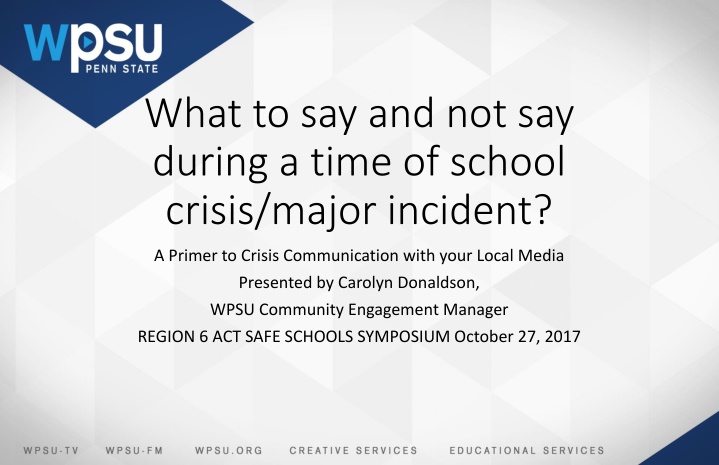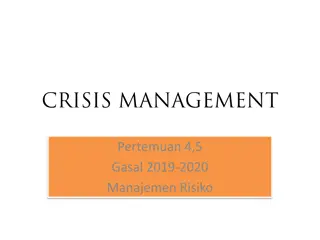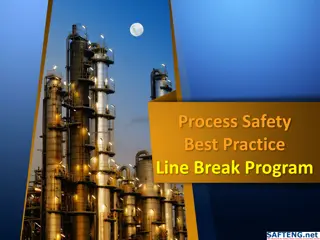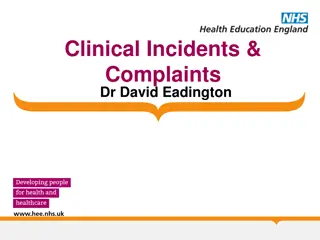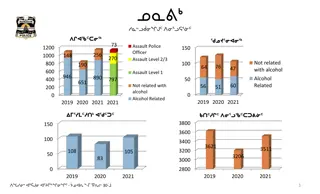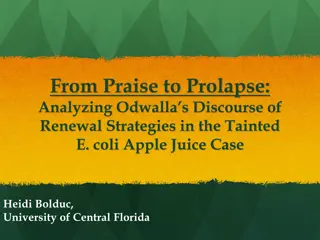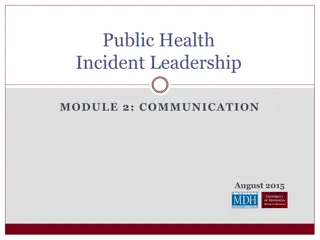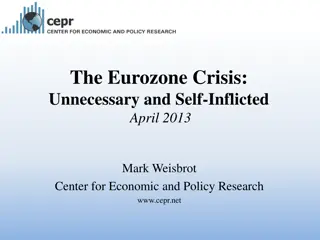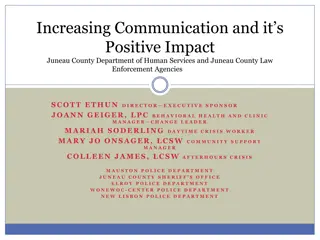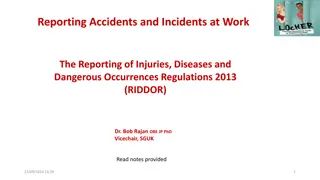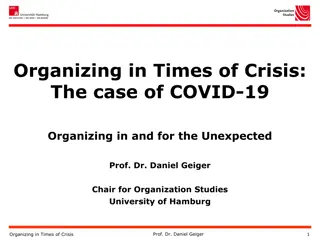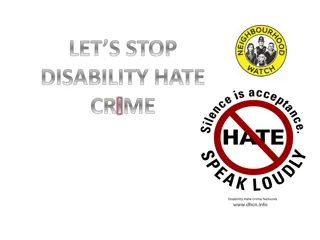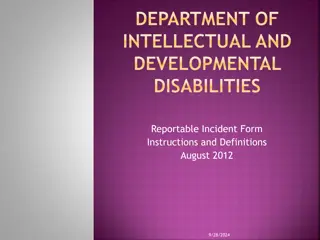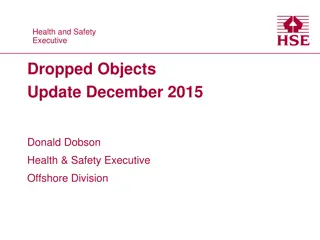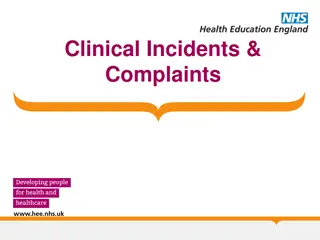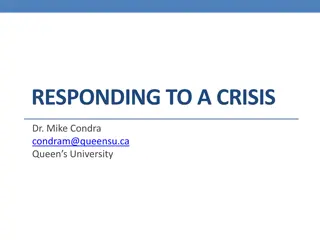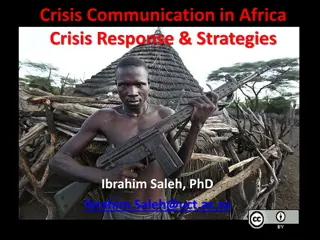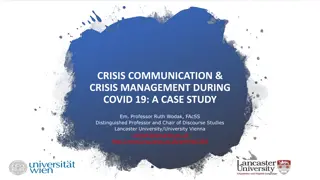Crisis Communication: What to Say and Not Say During School Incidents
In times of school crises, effective communication is key. Learn the dos and don'ts of crisis communication from Carolyn Donaldson, WPSU Community Engagement Manager, at the Region 6 ACT Safe Schools Symposium. Understand the impact of media reporting styles and the responsibility of school administrators. Discover the importance of implementing a crisis communication plan to maintain order and direction during challenging events.
Download Presentation

Please find below an Image/Link to download the presentation.
The content on the website is provided AS IS for your information and personal use only. It may not be sold, licensed, or shared on other websites without obtaining consent from the author.If you encounter any issues during the download, it is possible that the publisher has removed the file from their server.
You are allowed to download the files provided on this website for personal or commercial use, subject to the condition that they are used lawfully. All files are the property of their respective owners.
The content on the website is provided AS IS for your information and personal use only. It may not be sold, licensed, or shared on other websites without obtaining consent from the author.
E N D
Presentation Transcript
What to say and not say during a time of school crisis/major incident? A Primer to Crisis Communication with your Local Media Presented by Carolyn Donaldson, WPSU Community Engagement Manager REGION 6 ACT SAFE SCHOOLS SYMPOSIUM October 27, 2017
Television and Radio Reach Television 24 counties Four Digital Channels WPSU-TV WPSU Create WPSU World WPSU Kids 1.9 Million People Radio 13 counties Three Digital Channels WPSU-FM NPR, Entertainment WPSU-FM 2 NPR, Classical WPSU-FM 3 Jazz WPSU.ORG Averages 320,000 Users/Year
Simple Assumption It s not a matter of if your school will experience a crisis, it s a matter of when. Thanks to smartphones, the Internet, and social media, the news cycle is now 24/7/365. Being prepared to communicate and respond during a crisis is more critical than ever.
Two Styles of Media Reporting Chronicle Reporting Involves stories about the school play, school lunches, awards, retirements, special assemblies and programs, and board meetings (generally.)
Two Styles of Media Reporting Event Reporting Reporting style shifts into something less congenial when a crisis occurs. For event or crisis report, timelines change, focus is different and competition among various media organizations heats up.
Responsibility During Crisis The fundamental responsibility of a school administrator (Superintendent,etc.) in relating to the media when a crisis hits is to clearly outline the district s response to help bring semblance, order, and direction to an event that could otherwise degenerate into chaos.
Responsibility During Crisis To accomplish this, it is important to implement a thoughtful crisis communication plan including: Internal Communication Parents/Students, Employees, Board, Neighbors, Public through website and Social Media
Responsibility During Crisis To accomplish this, it is important to implement a thoughtful crisis communication plan including: External Communication working through the professional media depending on scope local, regional, national
Tylenol Scare of 1982 Crisis Communications Model
The Administrator and the Media Following Crisis 1. Be clear and factual. Reporters want to know the basics- who, what, when, where, why and it s important to provide as many facts as you know. Try not to guess, speculate, or inject your opinion even if asked to do so. If you don t know the answer to a question, say that you don t know the answer but will get information, if possible. Then follow up with the reporter. We re not certain We believe what occurred was The best information we have at this time is are all acceptable as long as what is stated as fact can stand scrutiny.
The Administrator and the Media Following Crisis 2. Be timely. Inquire about a reporters deadlines and try to help honor the deadlines by providing as much solid information as quickly as possible.
The Administrator and the Media Following Crisis 3. Be a good resource. Provide the names and contact information for other reliable, potential sources that can provide additional information or insights or explain technical information. These other sources may include emergency responders, board members, teachers or union representatives and contractors.
The Administrator and the Media Following Crisis 4. Demonstrate that district administration is in control. What is said is important, but also who says it is also important. The spokesperson (Superintendent/PIO) will convene news conferences and will be the primary contact person for the media as it relates to the school/district situation. The spokesperson can call on other representatives to speak, but district administration is in charge and that message should be reinforced. This strategy communicates that there is structure and is under control by a trusted and responsive institution.
Guidelines for Media Responses Description of Crisis Extent of involvement. Do not release names of suspects. Refer questions to law enforcement. Hint: Avoid conjecture. State only facts.
Guidelines for Media Responses Condition of Students/Staff Hint: Express concern for and empathy with victims. Hint: Speak from the viewpoint of public interest, not district s interest. Hint: Avoid jargon/acronyms - eg. LEP students, Special Needs, etc.
Guidelines for Media Responses Number injured/killed Potentially affected number. Nature of injuries. Care given to injured. Disposition of injured/fatalities. Example: Staff members have accompanied injured students to ______ hospital(s) until family members arrived.
Guidelines for Media Responses Name of person(s) injured/killed Do not release. Refer to law enforcement and coroner. They release all information regarding this. Hint: Next of kin are being notified first.
Guidelines for Media Responses Property Damage Estimated value. Hint: Avoid conjecture. Figures used by media may become Public Record. Example: There has been considerable damage. We are in the process of assessing the extent of loss. Description of damage Importance
Guidelines for Media Responses Causes How discovered. Chronology. Were any measures taken to avoid/eliminate/minimize the disaster? Example: Refer to Emergency Services/Crisis Plan as to actions followed.
Guidelines for Media Responses Rescue and Relief What is being done. Example: Refer to Crisis/Emergency Response Team. Personnel engaged in operation. How people/property were saved.
Guidelines for Media Responses People s Reactions How are students/staff/parents reacting? Example: Children/Students are safe; the situation is under control. School will remain open. Or: Children/Students have been safely evacuated to ___________ where parents or persons listed on their child s emergency card may pick them up.
Guidelines for Media Responses What help is available? Example: Crisis/Emergency Response Team are assisting students and staff.
Scenario 1 There has been a school bus accident (BUS #12) involving 35 students on the way to school. Driver of a car missed a stop sign and collided with side of bus. Unknown injuries at this time. Know of several transports via ambulance to hospital. http://news3lv.com/news/local/bus-crash-news-conference
Scenario 2 Reported Bullying incident on middle school grounds at the close of the school day - hit virally over Social Media Video. Conflict between 2 students and 1 non-student (adult). School Resource officer not on any video shown, but rumored to have been nearby as incident was going down . http://www.nj.com/morris/index.ssf/2017/08/school_district_we_trie d_to_stop_bullying_of_mallo.html
Scenario 3 Lockdown at all school sites near the SCI facility within 10 miles. Reports coming out of Social Media and confirmed by police and onsite. Media convening at police command post where all traffic has been stopped. Time of Day 2:15pm
Scenario 4 Reports of weapon carried into school by high school student. Previous supposed threats on social media posts of potential violence at school. Media received numerous calls from concerned parents about what is happening. Media converging on school building. Barrage of calls coming into school/district office.
Scenario 5 Natural Disaster in the form of rising waters in River/Creek bed behind elementary school due to heavy and continued rainfall. Area roads surrounding school are also becoming flooded. Mid-day School dismissal at 2:30pm Parents calling into TV stations and stopping reporter covering flooding to alert them of school situation. Media heading to scene of flooding - TV, etc.
Carolyn Donaldson, Community Engagement Manager cdonaldson@psu.edu THANK YOU!
